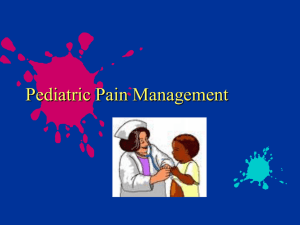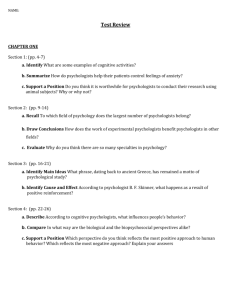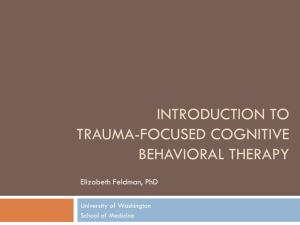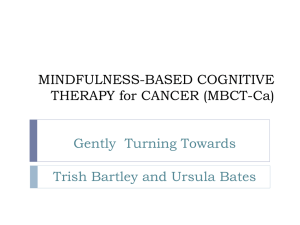Use of Cognitive Behavior Therapy with Students in Acute Distress
advertisement
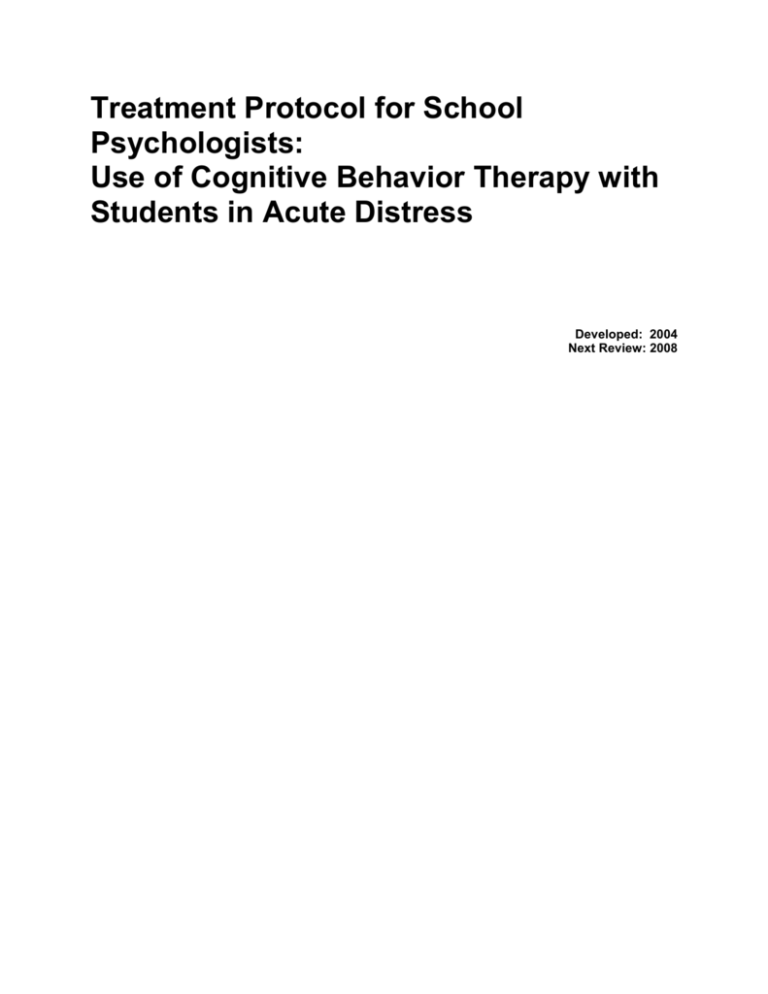
Treatment Protocol for School Psychologists: Use of Cognitive Behavior Therapy with Students in Acute Distress Developed: 2004 Next Review: 2008 Members of Protocol Development Team Robert Hull School Psychology Specialist, Maryland State Department of Education Charla P. Lewis University of Maryland, School-Based Therapist James Mount School Psychology Supervisor, Prince George’s County Public Schools Juan Paz School Psychologist, Baltimore City Public Schools / Adjunct Professor, Towson State University Nick Silvestri Resource School Psychologist, Anne Arundel County Public Schools / Board Member, Maryland School Psychologists Association Joni Tanaciev Assistant Director, American Federation of Teachers Health Care/ Parent of a Charles County Public Schools student Victor Welzant Educational Director, International Critical Incident Foundation / Trauma Specialist, Sheppard Pratt Hospital Maryland State Department Of Education Treatment Protocol for School Psychologists: Use of Cognitive Behavior Therapy with Students in Acute Distress 2 Introduction Currently schools are challenged to meet mandated and difficult decisions when determining how to respond to students who repeatedly act in a way that is dangerous to themselves and others. Typically, schools choose between disability under IDEA/504 or repeated suspensions, alternative placements, and expulsion. In either case, the system is often led into criticism, mediation, or hearings. This protocol will provide a structure for decision-making with students that expand the choices that schools can use to include evidence-based treatment strategies that have led to adequate yearly progress in inclusive environments for pervasively disruptive students. The No Child Left Behind Act requires schools to demonstrate adequate yearly progress for all students; it also requires that schools be considered safe. It can be quite difficult to have students achieve adequate yearly progress when they are excluded from the standard curriculum due to behaviors that are considered dangerous to themselves or others, not to mention the possibility of a school being designated as persistently dangerous due to the number of students suspended or expelled. Schoolbased staff are commonly confronted with children whose emotional status and readiness to learn have been disrupted by abuse, neglect, direct or witnessed community violence, and the devastation of AIDS and addictions-related death. These problems often lead to acting out behavior(s) in the school setting which do not respond to standard discipline procedures and do not fit the disability category of severely emotionally disabled. Recent surveys that were conducted in New Orleans and Chicago suggest that 75 to 90 percent of urban students ages 10 to 19 have been exposed to violent events (Osofsky 1993), (Shakoor 1990). Children exposed to these violent events often present as maladjusted or conduct-disordered (Raia 1995) which are specifically excluded from protections and eligibility for services under the IDEA. School psychologists and private providers of clinical services have often identified maladjusted students as having characteristics of depression, anxiety, and posttraumatic stress. This type of conflict exposes districts to opportunities for parents and advocates bringing cases to mediation. Under IDEA, maladjusted students are only ineligible if it is determined that they do not have an emotional disturbance in addition to their social maladjustment. This can lead to conflicting recommendations for eligibility under IDEA/504. The difficulty of this type of distinction is illustrated by the case of Muller v. East Islep Union Free School District, in which lower rulings were overturned by the Federal District Court. In this case, the district was held to provide for tuition for a nonresidential private placement, primarily due to eligibility issues regarding services under IDEA. The student was identified as conduct-disordered with multiple psychological symptoms. Administrators, counseling staff, and students frequently may not connect the cognitive, behavioral, and emotional deterioration that are present to exposure to community or family incidents. This leads students to present to staff in a way that suggests they are maladjusted, and staff to respond with methods that are traditional but ineffective. These methods often result in a quagmire of eligibility issues and issues regarding the appropriateness of repeated disciplinary procedures. If traditional Maryland State Department Of Education Treatment Protocol for School Psychologists: Use of Cognitive Behavior Therapy with Students in Acute Distress 3 methods of responding to students are not effective in changing behavior, the possibility of developing an intervention that focuses on treating cumulative stress secondary to exposure to ongoing violence can minimize exposure to criticism, mediation, and hearings. When confronted with students who do not respond to standard disciplinary procedures, ask yourself these questions: “How often is this student in a family or community situation where he or she could be seriously injured?” or “How often is this student in a family or community situation where he or she could witness someone being seriously injured?” and “How often has this student been separated from family members due to community or family disruption?”. If you belong to the growing list of educators who are confronted with students who are in these situations, then you have probably been frustrated with the effectiveness of the resources that you have to respond to these students. Group cognitive behavioral treatment programs have demonstrated significant levels of improvement with ten to twelve sessions (Freeman 1997, Stein et. al. 2003). Contrast this relatively inexpensive, minimally intrusive intervention with the cost and benefits of restrictive special education settings or alternative placements. Recent work by Raia and Jaycox reports success with students who are exposed to violence using specific treatment strategies that could be delivered in inclusive environments. This treatment has been validated in school settings. Treatment strategies for students who have been exposed to violence have been used by many of the clinics that are part of the National Child Traumatic Stress Network but have not generally been implemented in school environments. Evidence-based treatment strategies generally consist of specific limited sessions of cognitive behavior therapy. This approach emphasizes the concept of delivering service within inclusive settings and minimizing the amount of time that students are in alternative or restrictive settings. This protocol will provide guidance on how to implement these strategies at the initial level of school involvement with a combination of direct and indirect service. Districts can win the support of families by presenting an intervention strategy that does not necessarily label a child or require that the child attend a program that exposes the child to students with long-standing emotional disabilities and/or conduct disorders. School-based providers can deliver these services within the regular education settings through the use of intervention strategy plans developed by school support teams. This protocol will provide outlines of therapy and consultation plans for multiple grade levels. Maryland State Department Of Education Treatment Protocol for School Psychologists: Use of Cognitive Behavior Therapy with Students in Acute Distress 4 Purpose 1. Provide a targeted, brief treatment alternative for a specific population of students that can be utilized across grade levels and addresses symptoms that are expressed in behavioral, cognitive, emotional, or physical domains. 2. Identify students who are likely to respond to this treatment: a. Students for whom there have been published results in which brief CBT has been effective; b. Students for whom there is a probability that there is potential for more pronounced behavioral problems; c. Students for whom there is a documented negative educational impact; d. Students for whom there is a history of appropriate educational and behavioral functioning; and e. Applicable to all students regardless of age, or disability status. 3. Improve the efficiency of school-based mental health services by focusing efforts on services and away from a test and place model of psychological services. 4. Improve the safe and orderly conduct of education by decreasing repeated incidents of disruptive behavior. 5. Improve the resiliency of students by teaching coping strategies and building selfcapacities. Reduce the possible impact of repeated traumatic events. Identify students who are likely to respond to this treatment: 1. Students for whom there have been published results in which brief CBT has been effective. There have been multiple studies supporting the use of CBT with children who have a history of sexual abuse. There have also been studies to support the effectiveness of CBT with students who have had single incident stressors, as well as students who have been exposed to violence over extended periods of time. These studies have included students from Pre-K to adolescence. In addition, many studies have been published documenting this approach with adults. Possible positive outcomes for students include a decrease in multiple areas of mental health symptomatology, increased engagement in the educational process, an increase in attendance, and a decrease in disruptive behaviors. Maryland State Department Of Education Treatment Protocol for School Psychologists: Use of Cognitive Behavior Therapy with Students in Acute Distress 5 2. Students for whom there is a probability that there is potential for more pronounced behavioral problems. The DSM-IV R indicates that PTSD is associated with increased rates of conduct disorder, self-destructive behavior, depression, substance abuse, multiple anxiety disorders, and bipolar disorder. There has also been documentation of the association between untreated childhood trauma and increased risk for HIV infection. In a recent review of the literature published by the National Center for PostTraumatic Stress Disorder, the following groups were listed as having greater risk for long-term consequences: Females - effects were stronger and longer lasting. Disproportionate risk of minorities is attributed to differential exposure (cumulative effect) and lack of resources in the communities in which they live. Lower Socio-Economic Status - the effect of SES is stronger as severity of exposure increases. Parental psychopathology is one of the best predictors of child psychopathology; supportive and healthier parents limited impact. Household level of exposure: injury to family members, separation from family members and displacement were predictive of long-term adverse consequences. Pre-event status is considered the best predictor of post-event functioning. 3. Students for whom there is a history of appropriate educational and behavioral functioning. The students who are most responsive to the goals of returning to a pre-event status are those who were functioning well before the event. Intervening early with students who have a good academic record can avoid the possibility of these students being perceived as a discipline problem and/or as having a disability. The conditions under which these treatments have been studied were clinical in nature, which is different in significant ways than standard school psychology practice. The treatment staff: Had specific intense training in specific therapeutic techniques; Were given detailed treatment manuals; Had regularly scheduled clinical supervision; and Were able to maintain a consistent schedule of sessions. Maryland State Department Of Education Treatment Protocol for School Psychologists: Use of Cognitive Behavior Therapy with Students in Acute Distress 6 These issues must be addressed in order to expect the results published in the research in this area. Contact information regarding obtaining training and treatment manuals. These contacts provide detailed, standardized approaches to providing comprehensive treatment. Cognitive Behavioral Intervention for Trauma in Schools (CBITS) Lisa H. Jaycox, Ph.D. Senior Behavioral Scientist RAND 1200 South Hayes Street Arlington, VA 22202-5050 Phone: (703) 413-1100 x5118 Fax: (703) 414-4726 Web: http://www.rand.org/health/ Multi-Modality Trauma Treatment (MMTT) Program in Child and Adolescent Anxiety Disorders DUMC Durham, NC 27710 Phone: (919) 416-2400 Email: jsmarch@acpub.duke.edu Cognitive Behavioral Therapy for Child and Adolescent Traumatic Stress (CBT-CATS) Judith A. Cohen, M.D. Professor of Psychiatry Medical Director, Center for Traumatic Stress in Children & Adolescents Allegheny General Hospital 4 Allegheny Center, Room 859 Pittsburgh, PA 15212 Phone: (412) 330-4321 Fax: (412) 330-4377 Email: JCohen1@wpahs.org Maryland State Department Of Education Treatment Protocol for School Psychologists: Use of Cognitive Behavior Therapy with Students in Acute Distress 7 4. Applicable to all students regardless of age, or disability status. The recent work done by the Child Traumatic Stress Network supports the treatment of children from pre-k to adolescence. Their work has been used with multiple minority groups and has accommodations for children with mild disabilities. Contact the child traumatic stress network at: National Centers for Child Traumatic Stress NCCTS - University of California, Los Angeles 11150 W. Olympic Blvd., Suite 650 Los Angeles, CA 90064 Phone: (310) 235-2633 Fax: (310) 235-2612 NCCTS - Duke University 905 W. Main St., Suite 24-E, Box 50 Durham, NC 27701 Phone: (919) 682-1552 Fax: (919) 667-2350 Program Office of the National Child Traumatic Stress Initiative Center for Mental Health Services Substance Abuse and Mental Health Services Administration Department of Health and Human Services 5600 Fishers Lane Parklawn Building, Room 17C-26 Rockville, MD 20857 Phone: (301) 443-2940 Maryland State Department Of Education Treatment Protocol for School Psychologists: Use of Cognitive Behavior Therapy with Students in Acute Distress 8 Brief Cognitive Behavior Therapy With Students In Acute Distress Referral Procedures Referrals from parents, teachers or administrators will flow through existing school support teams and utilize those procedures for assessment, intervention development, and parent and teacher involvement. Assessment Concurrent efforts with school staff In addition to the normal assessment process that the school support or prereferral team makes to clarify the referral reason, careful assessment of whether traumatic events have occurred and to what degree they might be impacting the child in the four areas of behavior, cognition, and physical and emotional functioning should be completed. Another important aspect of this assessment is the determination of the functional capabilities of the student prior to single or multiple traumatic events. Assessing children exposed to traumas is a difficult task. In addition to assessment of the exposure to trauma, educators need to clearly indicate the impact of these exposures to the student’s ability to learn. Before any intervention begins, have staff describe the behavior that is interfering with education and collect baseline data on frequency duration and intensity. How much does his or her behavior impact the educational environment? An instrument such as the BASC teacher, parent, and selfreport can give information from multiple perspectives and in multiple domains, both negative and positive. The assessment of protective mechanisms or sources of invulnerability to the impact of extreme stressors is the first assessment that should be completed. In this way rapport is established and the school can work from strength rather than from weakness. Two established areas of protective mechanisms are social identity and support networks. Social identity is usually assessed by measuring things such as selfesteem, efficacy, group affiliation, and academic outcomes. Efficacy expectations determine how much effort children will expend and how long they will persist when faced with obstacles and aversive experiences. Exposure to trauma can lead to students who have established skills not feeling effective enough to use them in diverse situations. In this situation, the therapist might want to focus on building the confidence of the student that they are in a supportive educational environment and suggesting that previous coping abilities can apply to current and future situations. Social support is a resource network of people who are available, helpful, and invested in supporting the student in stressful situations. Traumatic events deeply impact the social support networks that children have available. Helping a child to identify and build new social support networks can be a way for the child to buffer Maryland State Department Of Education Treatment Protocol for School Psychologists: Use of Cognitive Behavior Therapy with Students in Acute Distress 9 against stress and to acquire resilience factors. School performance can be enhanced when students perceive school personnel as supportive and helpful rather than as an additional source of pressure and stress. To constructively employ a treatment program, the team needs to systematically discriminate between students with primary trauma/loss issues and students with more diffuse etiologies of their behavioral/emotional difficulties. The National Child Traumatic Stress Network has had success doing this in school settings via a multi-staged screening/interview protocol (The UCLA PTSD Reaction Index). Recently, Dr. Philip Saigh published the Children’s PTSD Inventory (Saigh, 1998). This child-adolescent structured clinical interview reflects the DSM-IV criteria for PTSD. The instrument consists of six subtests that denote exposure to traumatic experiences, situational reactivity, reexperiencing, avoidance, increased arousal, and functional impairment. In Dr. Saigh’s research he has clearly indicated that students with PTSD experience appreciably lower levels of academic performance relative to students exposed to similar levels of stress that did not have PTSD, therefore supporting the need for assessment that distinguishes between those students in which extreme stress has led to PTSD and functional impairment versus students who have been exposed to extreme stress and did not develop PTSD. The test may be ordered from the Psychological Corporation. This assessment instrument has received excellent reviews. It is a great tool for the majority of school psychologists who do not have extensive experience assessing this disorder and is particularly useful in making a differential diagnoses for PTSD. A review of various assessment devices can be found at: http://users.umassmed.edu/Kenneth.Fletcher/scales.html Maryland State Department Of Education Treatment Protocol for School Psychologists: Use of Cognitive Behavior Therapy with Students in Acute Distress 10 Intervention Before you get started: This protocol suggests several methods and approaches which may be helpful when responding to students in distress; at the same time we wish to acknowledge and respect the deep experience of school-based staff. We hope that this work allows you to optimize what works for you and promotes the use of each individual’s creativity, knowledge, and skills. It is suggested that a collaborative approach is absolutely necessary in responding to children in distress. Maintaining contact with family members, school staff, and other agencies that are involved with the student will greatly facilitate short and long term improvement. This work requires some changes in how school staff practice; providing a training session to school-based staff and administrators as a precursor to beginning on this work is highly recommended. Appreciate that trauma is often cumulative. Marlene Young, in the National Organization for Victim Assistance Training Manual, describes “disaster subcultures” - students with this kind of background are under constant threat and their feelings of anger and guilt often lead to an instrumental response to an event. In this case, allowing individuals to have safety checks with each other and helping others to cope is a precursor to them responding to their own feelings, therefore group therapy with this type of client is highly recommended. Maryland State Department Of Education Treatment Protocol for School Psychologists: Use of Cognitive Behavior Therapy with Students in Acute Distress 11 First Session Content : Expectations Rules Confidentiality Activities: Go over general introduction to a counseling relationship. Predict what will happen in sessions and prepare them for sessions. Build rapport through a strength assessment. Ask the student to remember: Accomplishments, skills, and talents; Special things about him/her self; The people who care about him/her; Kind things people have said or done for him/her; and Kind or generous things that he/she has done for others. Expected Outcomes: Development of a Respectful relationship; Sharing Information about counseling; Connecting with each other and having the child feel like they have someone who is interested in them; and Inspiring Hope that things can get better (RICH). Statement of goals of treatment. Maryland State Department Of Education Treatment Protocol for School Psychologists: Use of Cognitive Behavior Therapy with Students in Acute Distress 12 Second Session Content: Educate about trauma. Activities: Review of previous weeks session. Relate the events that the child has had to thoughts, feelings, symptoms, and reactions; Emphasize the impact of discussing the event on reducing the intensity of reactions (affect modulation); Normalize the student’s reactions. Educate about normal reactions to abnormal events; Discuss student’s strengths and work to elicit previous existing coping mechanisms in relation to current events; and Discuss the idea that there are many methods of expressing feelings. Suggest that students keep a journal that can include artwork or drawings. Expected outcomes: Student will decrease the frequency, duration, and intensity of behavioral, cognitive, emotional, and/or physical reactions that impact the educational environment. Maryland State Department Of Education Treatment Protocol for School Psychologists: Use of Cognitive Behavior Therapy with Students in Acute Distress 13 Third Session Content: Building connections Activities: Review previous sessions. Have student describe a positive relationship that he/she has. Contrast that with an abusive exploitive relationship. (Address the assumption that all relationships are negative). Describe attachment and the impact of a relationship as a foundation for developing other relationships and a successful experience in school. Work to diminish the isolation that the student experiences; for many students the idea that they do not have to do things alone is a radical model for coping. Sometimes it is difficult for students to identify relationships that are positive, or think of someone who they could talk to. If that is the case, then doing this work in a group setting often generates connections between students. Clinicians have indicated that these relationships can support students throughout the week. Expected outcomes: Student will be able to access educators as helpers in learning and coping. Student will not overreact to the offer of assistance by peers and adults but will actually welcome assistance. Maryland State Department Of Education Treatment Protocol for School Psychologists: Use of Cognitive Behavior Therapy with Students in Acute Distress 14 Fourth Session Content: Coping strategies Activities: Review previous sessions. Evaluate child’s current coping strategies by reviewing strengths and previous successes. Help him or her to appreciate how sometimes he or she is able to succeed despite overwhelming odds against them. Determine if the child has coping strategies but is not using them or if child does not have the basic coping strategies. If child is lacking in coping strategies, teach them. If child is not using existing coping strategies, help him or her to recognize that he or she has them and facilitate their use in educational environments. Role-play using coping strategies to manage feelings. Role-play responding to the need for help with schoolwork from peers and from the teacher. Practice connecting to others, seeing them as supports, not as obstacles. Discuss counselor’s involvement with teachers and administrators. Relaxation exercises should be taught in order to assist students to monitor and respond to their emotional reactions. During this session, the clinician might want to introduce some books and activities. At the elementary school level, there are some great books and games to help develop coping strategies: “Don't Pop Your Cork on Monday" (Anti-stress Management) "Don't Feed the Monster on Tuesday" (Self-esteem Management) "Don't Rant and Rave on Wednesday" (Anger Management) "Don't Despair on Thursday" (Grief Management) These are all by Adolf Moser. They offer a lot of strategies that kids can use in a format that is entertaining. These materials can support session five as well. Expected outcomes: Student will use identified coping strategies as a replacement for behaviors that have historically disrupted learning. Reduced frequency duration and intensity of disruptive behaviors. The fourth session might have to be repeated or continued. Maryland State Department Of Education Treatment Protocol for School Psychologists: Use of Cognitive Behavior Therapy with Students in Acute Distress 15 Fourth Session (Part Two) (Taken from the work done by Dr. Judith Cohen et al. Allegheny General Hospital, Pittsburgh, PA) Content : Trauma-focused interventions Activities: Cognitive processing refers to a variety of interventions that encourage students to explore their thoughts about traumatic events and to challenge and correct cognitions that are inaccurate or unhelpful. Inaccurate cognitions are thoughts that are false. These statements can represent hero fantasies or may represent a student’s attempt to gain a sense of control at the cost of blaming oneself. Help the student to challenge these thoughts with repeated explanations of the concepts of: 1. Role confusion: child feeling responsible when a parent is arrested for drugs which leads to a breakup of the family. 2. Accident: sometimes people make mistakes that lead to dangerous situations. 3. Unfortunate coincidence: being at the wrong place at the wrong time. Accurate but unhelpful cognitions are thoughts are typically accurate but focus on the most horrifying realities or possible realities of traumatic events. Focusing on horrifying events is a choice, not a necessity. When exploring thoughts about events in such a way, it can often impair a person’s ability to cope with the trauma and loss. In each of these situations the counselor should encourage students to generate alternative thoughts that are more accurate or helpful in order to feel differently. Delicately but firmly explore the concept that blaming oneself for tragic events does not lead to control. Bad things do happen to good people. Be prepared for a range of possible strong emotions. Make sure you praise and reward the student after this kind of effort so they are very clear that this was a valuable experience. Expected Outcomes: Return to baseline levels of cognitive functioning. An increase in focus, attention and organizational skills should be seen as well as an ability to relate to others in an age appropriate fashion, acceptance of authority figures, and a decrease in generic role confusion. Maryland State Department Of Education Treatment Protocol for School Psychologists: Use of Cognitive Behavior Therapy with Students in Acute Distress 16 Fifth Session Content: Relate coping to impact on education; behavior, academic performance Activities: Review previous sessions. Review whether coping strategies were effective. Trouble shoot continued problematic areas. Enhance stress management and management of feelings by talking about possible triggers in everyday life and relate to coping skills. Reinforce teaching about replacing triggered behavior with coping behavior. Talk about the control that was obtained over the last few sessions and how that should impact the student’s feelings of self-worth. Expected outcomes: Continued and enhanced use of identified coping strategies as a replacement for behaviors that have historically disrupted learning. Reducing the frequency duration and intensity of disruptive behaviors and an increase in behaviors that enhance learning. The fifth session might have to be repeated or continued. Maryland State Department Of Education Treatment Protocol for School Psychologists: Use of Cognitive Behavior Therapy with Students in Acute Distress 17 Sixth Session Content: Relapse prevention Activities: Discussed what has worked. Discuss impact of stress on use of coping mechanisms. Discuss the possibility of unpredictable sudden temporary upsurges of previous feelings and behaviors predict that these will happen and develop a plan to respond. Evaluate progress in relation to stated goals. Describe current support network. Expected outcomes: Independent use of identified coping strategies as a replacement for behaviors that have historically disrupted learning. Reducing the frequency duration and intensity of disruptive behaviors and an increase in behaviors that enhance learning. Student will develop a plan to use in response to stress and use the plan. Maryland State Department Of Education Treatment Protocol for School Psychologists: Use of Cognitive Behavior Therapy with Students in Acute Distress 18 Intervention with School Team The primary setting in which children spend their time in school is in the classroom. School staffs have been exposed to children with multiple problems for a long time and have developed a significant degree of skill in responding to their needs. In many ways they are the primary service providers when it comes to developing the skills necessary for children to succeed. Therefore, connections between school staff and the mental health provider can often be the best source of successful interventions. When child is enrolled in treatment: Attempt to build advocacy for the student. Work to impact possible adversarial relationship between staff and child/family. Service provider should involve themselves in a consulting relationship with school staff. After fourth session: Inform staff of what coping strategies have been developed and have them encourage the child to use them. Begin collecting data on use of coping strategies and use data in next sessions. Once treatment is discontinued: Discuss the possibility of unpredictable sudden temporary upsurges of previous feelings and behaviors. Predict that these will happen and develop a plan to respond. Review baseline data with current behavior. Maryland State Department Of Education Treatment Protocol for School Psychologists: Use of Cognitive Behavior Therapy with Students in Acute Distress 19
